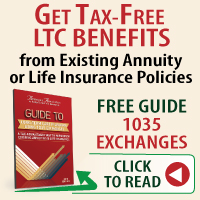1099 LTC - IRS Form Reporting Long Term Care Insurance Benefit Payments
Understanding IRS Form 1099 LTC
Insurance companies that pay long-term care insurance benefits are required by the Internal Revenue Service (IRS) to provide claimants with a 1099 LTC – Copy B Form that reports payments made under a long term care insurance contract. Insurers typically issue 1099 LTC Forms in January for the prior tax year.
The Form 1099-LTC report reflects payments made directly to you as well as those payments made to third parties on your behalf.
People are often surprised to receive this report. And, it is a natural reaction to see that the amount reported to the IRS could be $20,000 … $40,000 or even $80,000 and then to worry that now taxes are owed on this amount.
The fact that you receive this form does not necessarily mean that the amounts reported are taxable income to you. In addition, benefits declared are often offset by expenses that can be deducted. This is something you should discuss with whoever prepares your taxes. Additional information can be found on the Internal Revenue Service website.
IF YOU PREPARE YOUR OWN TAX FORMS
Request the Instructions for Form 1099-LTC from the IRS. You can request free tax forms and guides by calling the IRS at 1-800-TAX-Form or 1-800-829-3676.
The American Association for Long Term Care Insurance does not provide tax or tax planning guidance. However, because we often receive calls from concerned family members, we are pleased to share the following explanation of the meaning of numbers reported in each box on the 1099 LTC.
Box 1. Gross benefits paid by the particular long term care insurance company.
Box 2. This is not applicable to long term care.
Box 3. Reports benefits paid as shown in Box 1 as either on a Per Diem basis (such as from an Indemnity plan that pays a set dollar amount) or as a Reimbursement for actual long term care expenses incurred.
Box 4: This is an optional field that indicates if benefits were paid from a Tax Qualified long term care insurance contract.
Box 5: For long term care the 'Chronically Ill' box will be checked. The Terminally Ill box is not applicable to long term care.
PAYER'S NAME: Will list the insurance company's name and address.
OMB No.: Indicates the tax year for which amounts are reported.
PAYER'S FEDERAL IDENTIFICATION NUMBER: Is the federal tax identification number for the insurance company which paid the benefit amounts.
POLICYHOLDER'S IDENTIFICATION: Is the policyholder's identification number, which should be the same as what is in box 10, the insured's Social Security number
INSURED'S SOCIAL SECURITY: The Social Security number, name and address for the insured who was the recipient of benefits.
Account Number: Is the actual claim number. This box may also contain the Total Number of Days paid if the policy is an Indemnity (per diem paid) policy.
Date Certified: If the policy uses a Reimbursement formula, this box will show the date certified as Chronically Ill. If the policy uses a Per Diem (indemnity) formula, it will show the claim's original date of loss.
Additional Explanations Regarding Box 3
1. If Box 3 is marked "Reimbursed Amount" and the policy is categorized as a Tax Qualified Contract, then the amount of money received can generally be excluded from the income being reported. The insurance company can tell you if your policy is considered a Tax Qualified policy.
A tax qualified long term care insurance contract qualifies for favorable federal income tax treatment. If the policy only pays benefits that reimburse you for qualified long term care expenses you will not owe federal income tax on these benefits.
2. If Box 3 is marked "Reimbursed Amount" and you have a Non-Tax Qualified Contract, then some or all of your benefits may be taxable. Again, the insurance company can tell you if your policy is considered a Non-Tax Qualified policy.
A Non-Tax Qualified policy may result in some or all of your benefits being taxable. You or the person preparing tax submissions will need to determine the taxable portion of non-qualified long term care benefits for purposes of an individual income tax return.
3. If Box 3 is marked "Per Diem" (which will happen for policies that are considered Indemnity policies) then the amount you may exclude from taxable income being reported is limited.
Because benefits were paid on a per diem (indemnity) basis, without regard to the actual long term care expenses incurred; the amount of benefits that may be excluded from income is subject to a daily maximum amount.
If this per diem (indemnity) limitation is exceeded, part of the benefits received may be taxable. The amount of the limitation increases every year and is included on our website under the page long-term care insurance tax benefits.
Get No-Obligation Long Term Care Insurance Costs
We recommend reading free guides that provide excellent information and advice on reducing long term care insurance costs. Simply click the link. There is NO sign-in information required to read the guides which were originally published by the Association in Kiplinger's Personal Finance magazine issues.
Let a designated long-term care insurance professional show you how a 1035 exchange can benefit you and compare costs from leading insurers. Click here to complete our simple online questionnaire.




